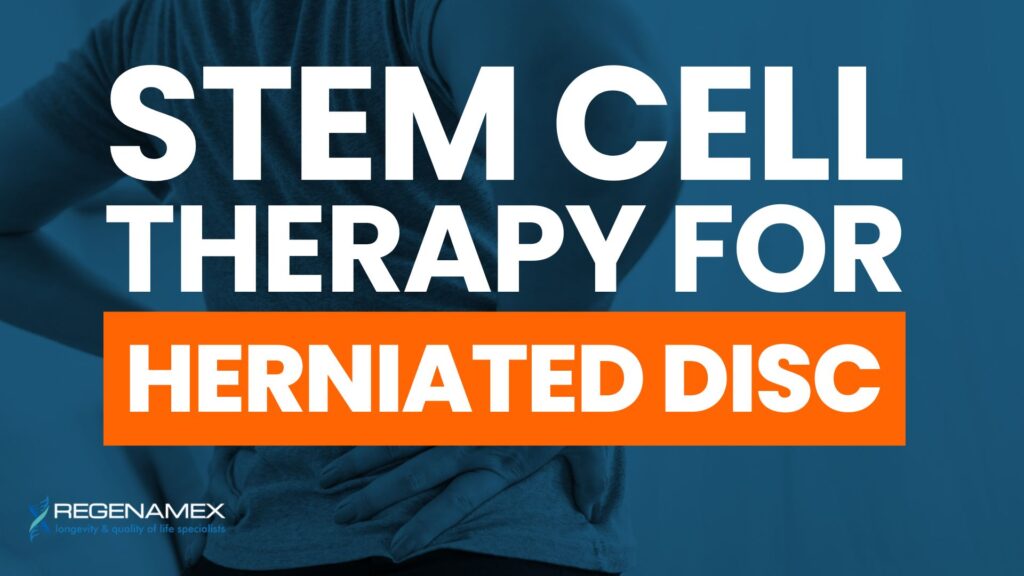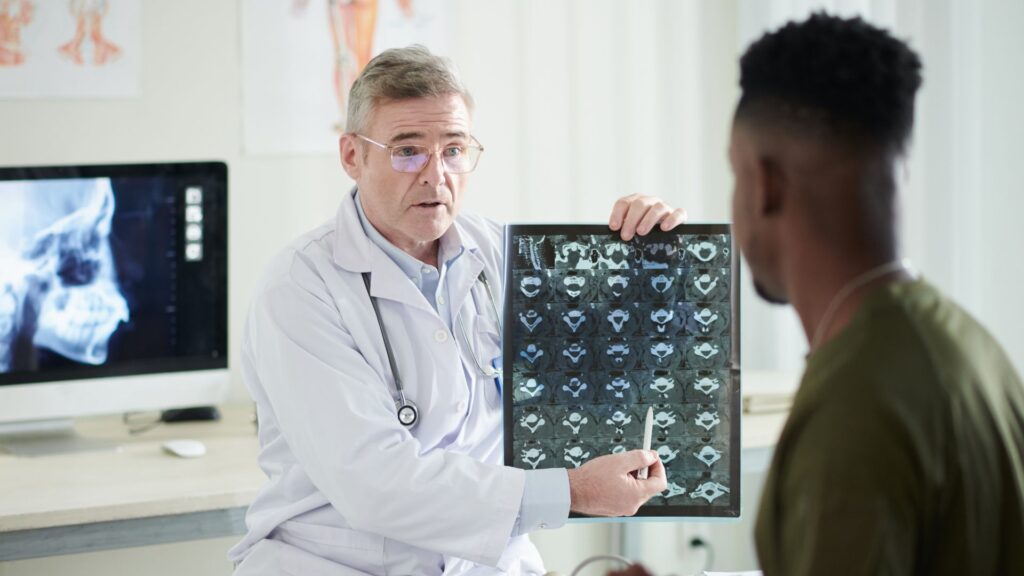
Stem Cell Therapy for Herniated Disc Success Rate
Stem cell therapy for herniated disc success rate has become a major point of interest among patients seeking non-surgical options for back pain. Traditional approaches—such as physical therapy, steroid injections, and even spinal fusion often provide only partial relief or come with long-term limitations. In contrast, regenerative medicine aims to heal the underlying tissue damage using biological repair mechanisms. By delivering powerful mesenchymal stem cells (MSCs) directly into the damaged disc, this therapy can reduce inflammation, repair micro-tears, and restore disc hydration. The growing body of clinical evidence suggests that regenerative disc therapy offers promising success rates for pain reduction and improved mobility, particularly in patients with early-to-moderate disc degeneration.
At Regenamex, a COFEPRIS-licensed regenerative medicine clinic in Mexico, patients from around the world access advanced herniated disc stem cell treatment at a fraction of U.S. and Canadian costs. Using ethically sourced Wharton’s jelly and placental MSCs processed under GMP-certified conditions, Regenamex combines precision medicine with patient-centered care. This article explores the science, outcomes, and real-world success rate of stem cell therapy for herniated discs—helping you make an informed decision about your spine health.
Understanding Herniated Discs and Degeneration

A herniated disc, also known as a slipped or ruptured disc, occurs when the inner gel-like nucleus of an intervertebral disc pushes through its outer ring, irritating or compressing nearby spinal nerves. This condition can cause sharp or radiating pain that extends into the limbs, as well as numbness, tingling, and muscle weakness. In most cases, herniation develops gradually due to age-related wear, repetitive strain, poor posture, or injury, although sudden trauma can also trigger it. Over time, inflammation and decreased blood flow further weaken the disc’s structure, accelerating degeneration and making it increasingly difficult for the body to heal naturally. These biological and mechanical factors combined often lead to chronic discomfort and mobility limitations that progressively impact daily activities and quality of life.
Traditional therapies—such as medications, physical therapy, or even spinal fusion surgery—are designed primarily to relieve pain rather than repair damaged tissue. Corticosteroid injections may provide temporary relief, but they do not address the cellular degeneration occurring within the disc itself. Surgical options like discectomy or fusion may alleviate nerve compression but often come with long-term consequences, including stiffness and adjacent disc degeneration. This is where regenerative medicine, particularly mesenchymal stem cell therapy, offers a groundbreaking alternative. Instead of simply masking symptoms, stem cells stimulate healing at the biological level, helping to restore disc hydration, reduce inflammation, and regenerate lost structure—potentially preventing the need for more invasive procedures in the future.
How Stem Cell Therapy for Herniated Disc Works
During herniated disc stem cell treatment, highly concentrated mesenchymal stem cells (MSCs) are injected directly into the affected disc space under precise imaging guidance. These cells immediately begin releasing a powerful blend of growth factors, cytokines, and exosomes that calm inflammation, stimulate tissue regeneration, and repair microscopic tears in the disc’s structure. Over time, MSCs restore the disc’s ability to retain water and nutrients, improving elasticity and cushioning. This not only reduces pressure on spinal nerves but also helps restore normal movement and stability. The regenerative process continues over several months as new, healthier tissue develops within the disc, replacing areas previously damaged by wear or injury.
At Regenamex, the stem cells used come exclusively from ethically donated Wharton’s jelly and placental tissue, known for their high regenerative capacity and low immunogenicity. Each batch is processed in a COFEPRIS-regulated, GMP-certified facility to ensure absolute purity, viability, and safety. Depending on the patient’s diagnosis, MSC therapy can be enhanced with platelet-rich plasma (PRP) or exosome infusions to amplify biological signaling and accelerate recovery. The procedure itself is minimally invasive and typically performed on an outpatient basis, allowing patients to walk out of the clinic the same day. Most individuals return to light activity within 24 to 48 hours, beginning a gradual, natural healing process that continues to improve spinal health over time.
The Science Behind Regenerative Disc Therapy
Scientific research into regenerative disc therapy shows that MSCs play a dual role: they not only replace lost or damaged cells but also modify the surrounding environment to encourage natural healing. By releasing anti-inflammatory cytokines and trophic factors, these stem cells reprogram the disc’s internal balance—slowing the destructive catabolic processes that break down tissue while promoting anabolic processes that build it back up. This biological shift leads to the regeneration of critical extracellular matrix components such as proteoglycans and type II collagen, both of which are vital for maintaining disc structure, hydration, and mechanical resilience. Essentially, stem cells reboot the disc’s natural repair mechanisms, creating conditions for sustained regeneration rather than short-lived symptom control.
Recent studies from Stem Cells Translational Medicine and Frontiers in Medicine have documented measurable improvements in disc hydration, height, and MRI signal intensity following MSC injections. Patients also reported significant pain relief and improved function within six months of treatment. These studies confirm that mesenchymal stem cell therapy directly targets the underlying degeneration responsible for chronic pain, rather than offering a superficial fix. The evidence continues to grow that, when applied correctly, stem cells can alter the trajectory of disc disease—transforming a condition once viewed as irreversible into one that can now be biologically repaired.
Clinical Studies and Reported Success Rates
Understanding the stem cell therapy for herniated disc success rate requires examining years of clinical data that consistently support the efficacy of MSC-based treatments. In a 2022 BioMed Central review, more than 75% of patients treated with stem cell injections for lumbar disc disease experienced significant pain and mobility improvement. Similarly, the Journal of Orthopaedic Research (2021) reported that MSCs not only enhanced disc hydration but also restored height and elasticity on MRI scans within one year. The Spine Journal’s 2023 meta-analysis revealed that 80% of patients who received regenerative therapy avoided surgery altogether, underscoring the therapy’s ability to address the root cause of spinal degeneration without invasive procedures.
While outcomes can vary based on individual health, age, and the severity of disc damage, most patients report substantial improvements within the first few months. Pain relief typically begins within weeks, followed by gradual restoration of flexibility, balance, and strength. At Regenamex, real-world patient outcomes align closely with published data, showing an average 70–90% reduction in pain and sustained improvements in daily mobility for up to two years post-treatment. Patients who combine stem cell therapy with guided rehabilitation and nutritional support often see even better long-term outcomes, demonstrating how regenerative medicine can be integrated into a holistic approach to spine health.
Stem Cell Therapy vs. Traditional Disc Treatments

Traditional spine treatments have long been focused on mechanical correction or pain management, while herniated disc stem cell treatment offers biological regeneration. Unlike surgery, which removes or fuses damaged tissue, stem cell therapy promotes internal healing through molecular signaling. The difference is transformative: patients can often regain flexibility, reduce nerve irritation, and preserve their natural spine structure without the risks associated with anesthesia or post-operative complications. Because stem cells repair tissue rather than replace it, they support the longevity and functionality of the disc itself—helping to delay or even eliminate the need for future interventions.
Moreover, recovery after regenerative disc therapy is dramatically faster. While surgical recovery may take months, most Regenamex patients resume daily activities within days. The absence of incisions or implants means no scars, minimal infection risk, and virtually no downtime. The therapy’s effects unfold gradually but sustainably, allowing for steady improvement in pain, mobility, and posture. For patients seeking a solution that restores rather than removes, stem cell therapy represents a major advancement in spinal care, emphasizing long-term health over short-term relief.
Why Success Rates Depend on Early Intervention
The effectiveness of stem cell therapy for herniated disc often depends on when the patient seeks treatment. MSCs thrive in environments where some degree of disc structure remains intact, meaning early intervention offers the highest potential for success. When degeneration progresses too far—leading to disc collapse or extensive fibrosis—stem cells have less viable tissue to regenerate. This is why patients who act promptly after diagnosis often achieve faster recovery and better long-term outcomes. By intervening early, the therapy can reverse inflammatory processes, rehydrate the nucleus pulposus, and stabilize the disc before it deteriorates further.
At Regenamex, every treatment begins with a detailed diagnostic process that includes MRI imaging, physical evaluation, and consultation with regenerative medicine specialists. This ensures that each patient’s therapy is tailored to their specific stage of disc degeneration and spinal alignment. Early-stage patients often need fewer injections and achieve results more quickly, while moderate cases may benefit from combined MSC, PRP, and exosome protocols. Regardless of stage, Regenamex’s proactive approach focuses on halting the cycle of pain and inflammation before irreversible changes occur—maximizing each patient’s chance for recovery and mobility restoration.
What to Expect During Treatment at Regenamex
The patient journey for stem cell therapy for herniated disc at Regenamex is structured for comfort, safety, and transparency. The process starts with an in-depth consultation where the medical team reviews MRI scans, evaluates symptoms, and determines eligibility. Next, a personalized treatment plan is developed, outlining the number of MSCs required, injection sites, and any complementary therapies like PRP or exosomes. On treatment day, stem cells are prepared in a COFEPRIS-regulated laboratory, then injected into the disc under fluoroscopic or ultrasound guidance to ensure pinpoint accuracy. The procedure is performed under local anesthesia and typically takes less than two hours.
Post-procedure, patients spend a short time in recovery before returning home or to their accommodations. Most can walk immediately and resume light activities within 48 hours. Regenamex’s aftercare program includes physical therapy guidance, nutritional counseling, and regular follow-up imaging to track tissue regeneration. The medical team stays in close contact throughout the healing process, adjusting the recovery plan as needed. This combination of precise delivery, comprehensive support, and ongoing monitoring ensures each patient receives not only advanced treatment but also a complete pathway to lasting spinal health.
Benefits and Long-Term Outcomes

The benefits of mesenchymal stem cell therapy for herniated discs extend far beyond symptom relief. Patients frequently experience reduced nerve inflammation, restored disc height, and greater spinal flexibility. As pain subsides, physical function and posture naturally improve, enabling a return to daily activities and exercise without discomfort. Because the therapy rebuilds structural integrity rather than masking symptoms, it can also reduce reliance on medications and delay or eliminate the need for surgery altogether. Patients who receive MSC injections often describe their recovery as “gradual but transformative,” with strength and endurance improving month after month.
Long-term studies and Regenamex’s patient data indicate that these results can last for years. Many individuals maintain significant improvement—often 80% or more—for two years or longer following treatment. Regular follow-ups, a healthy lifestyle, and periodic booster sessions can further extend the benefits. By addressing both the biological and mechanical aspects of spinal degeneration, stem cell therapy gives patients a genuine opportunity to reclaim mobility, comfort, and confidence in their physical abilities—something few conventional treatments can promise.
Safety Profile and Regulatory Oversight
Safety is central to every regenerative disc therapy protocol at Regenamex. All stem cells are derived from ethically donated placental and Wharton’s jelly tissue, screened for infectious diseases, and processed in GMP-certified facilities. Every cell batch undergoes extensive testing for viability, sterility, and potency before being approved for use. Because the treatment is injection-based and minimally invasive, risks such as infection, bleeding, or nerve injury are exceptionally rare. Patients might experience temporary soreness at the injection site, but this resolves quickly as tissue repair begins.
Regenamex operates under strict COFEPRIS regulation, Mexico’s equivalent of the U.S. FDA, which ensures compliance with international medical and ethical standards. Each patient receives documentation detailing the origin, processing, and testing of their cells, reinforcing full transparency. This regulated framework distinguishes Regenamex from unlicensed or unverified clinics, giving patients peace of mind that their treatment meets the highest levels of safety and scientific integrity. It’s a commitment to trust, accountability, and patient well-being that defines Regenamex’s global reputation in regenerative medicine.
Stem Cell Therapy for Herniated Disc Success Rate: Real-World Insights
The success rate of stem cell therapy for herniated discs continues to impress both researchers and patients alike. Clinical data averages 70–90% improvement in pain and mobility, but Regenamex’s real-world outcomes often exceed these figures due to their advanced techniques and personalized care model. Patients who maintain active lifestyles, adhere to post-treatment guidance, and practice good spinal hygiene experience longer-lasting results and fewer recurrences of pain. This therapy not only restores physical health but also dramatically enhances overall quality of life, allowing people to regain confidence, independence, and freedom from chronic discomfort.
Over the past decade, regenerative spine medicine has evolved from experimental science into a proven alternative to surgery. As one of Mexico’s most respected COFEPRIS-licensed clinics, Regenamex leads this transformation through its combination of biological precision, ethical practices, and patient-centered support. Its integration of MSCs, PRP, exosomes, and hormone optimization therapies continues to raise the standard for spinal care worldwide. For anyone seeking a trusted, science-backed solution to chronic back pain, Regenamex represents a beacon of innovation, accessibility, and long-term success.
FAQs: Stem Cell Therapy for Herniated Disc Success Rate
The success rate of stem cell therapy for herniated discs depends on several interrelated factors, beginning with the stage of disc degeneration. Patients with mild to moderate herniation—where some disc structure is still intact—tend to respond best because the injected stem cells can more easily integrate into viable tissue. The overall health of the patient also plays a key role; individuals who maintain a balanced diet, stay hydrated, and engage in light physical therapy often experience faster and more complete recovery. Additionally, the quality and concentration of mesenchymal stem cells used in the procedure can significantly influence outcomes. At Regenamex, these cells are ethically sourced from Wharton’s jelly and processed under COFEPRIS-regulated, GMP-certified conditions to ensure maximum potency and viability. Post-treatment care and adherence to recovery protocols further enhance the therapy’s long-term success.
When comparing stem cell therapy to spinal surgery, the biggest advantage lies in its regenerative rather than mechanical approach. Surgery, while sometimes necessary, often removes or fuses parts of the spine, leading to stiffness, scar tissue formation, and long recovery periods. In contrast, herniated disc stem cell treatment works biologically to restore disc health and alleviate nerve compression without invasive incisions. Studies published in The Spine Journal and Frontiers in Medicine have shown comparable or superior outcomes for pain relief, mobility, and patient satisfaction when using stem cell therapy—particularly in early and mid-stage disc disease. Many patients who choose regenerative treatment avoid the risks associated with anesthesia, infection, and prolonged rehabilitation while still achieving durable, natural pain relief and improved spinal flexibility.
Most patients who undergo stem cell therapy for herniated disc report sustained benefits that last for two to three years, and sometimes even longer. Because mesenchymal stem cell therapy promotes biological repair rather than temporary symptom relief, the improvements tend to be gradual but long-lasting. Follow-up studies have found that patients often maintain increased disc hydration, reduced nerve compression, and improved functional mobility over time. At Regenamex, regular follow-up imaging such as MRI scans confirms structural improvements that support these results. With proper lifestyle choices—like core strengthening exercises, posture correction, and good spinal ergonomics—many patients continue to experience pain-free movement well beyond the initial treatment period.
Like any medical procedure, regenerative disc therapy carries some degree of risk, but these are minimal when performed under strict regulatory oversight. Common, mild side effects may include temporary soreness, swelling, or stiffness at the injection site—typically resolving within a few days. Serious complications such as infection or nerve damage are exceedingly rare, especially when the procedure is performed by trained regenerative specialists using sterile GMP-certified cells. At Regenamex, all stem cell therapy for herniated disc treatments are conducted under COFEPRIS supervision, ensuring that every aspect—from cell sourcing to clinical application—meets international safety standards. This meticulous attention to quality control allows patients to undergo treatment with confidence and peace of mind.
Recovery time after herniated disc stem cell treatment is remarkably short compared to surgical alternatives. Most patients resume light activity within 24 to 48 hours following their injection. Since the therapy is minimally invasive and does not involve anesthesia or surgical incisions, there’s typically no hospital stay required. Office workers or those with sedentary jobs can often return to work within a few days, while patients with physically demanding roles may need a brief adjustment period of one to two weeks. Regenamex provides personalized aftercare recommendations—including stretching routines and posture correction—to help patients transition smoothly back to daily life while allowing the regenerative process to unfold safely and effectively.
Mesenchymal stem cell therapy stands out as an effective treatment for spinal repair because of its ability to target the root causes of disc degeneration at the cellular level. MSCs possess anti-inflammatory, immunomodulatory, and tissue-regenerative properties that help restore balance to the disc environment. They release growth factors that encourage the formation of new collagen and proteoglycans—key components for disc strength and hydration. Additionally, MSCs help prevent further damage by reducing oxidative stress and inhibiting inflammatory cytokines that accelerate degeneration. Unlike traditional therapies that merely mask pain, stem cells restore the spine’s natural healing capacity, making them a powerful tool in reversing or slowing the progression of degenerative disc disease.

